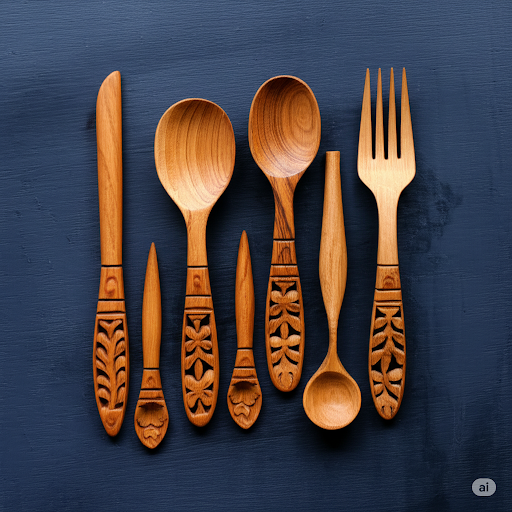Nestled in the Nellore district of Andhra Pradesh, the town of Udayagiri is renowned not only for its historical fort but also for its exquisite wooden cutlery. This traditional craft, a testament to the fact that art can make even the most mundane aspects of everyday life beautiful, showcases the skill and artistry of local artisans who transform simple pieces of wood into functional and aesthetically pleasing objects. The Udayagiri wooden cutlery is more than just utensils; it is a testament to the region’s rich cultural heritage and the enduring legacy of its craftspeople.
History and Significance
The art of making wooden cutlery in Udayagiri has a long and storied past, believed to be around 150 years old. It flourished under the patronage of the royal families of the region, including the Nawabs of Arcot and the jagirs, during whose rule highly-decorated wooden cutlery became particularly popular. Historically, these finely carved spoons, forks, knives, and bowls were an integral part of everyday life, valued for their utility and decorative appeal.
Udayagiri’s own history dates back to the 14th century, when it was the local kingdom of the Gajapatis of Odisha. Their chieftain, Languja Gajapati, built the iconic Udayagiri fort. Subsequently, it came under the rule of Krishnadevaraya of the Vijayanagara kingdom, then chieftains of Golconda, and later the Nawabs of Arcot. This rich historical tapestry provided the fertile ground for the development and patronage of such an intricate craft.
The Story of Udayagiri Wooden Cutlery: From Forests to Fine Art
Udayagiri wooden cutlery consists of forks, spoons, knives, and bowls, beautifully carved with distinct Persian-inspired motifs. The craft has been passed down from artisan to artisan over generations. Traditionally, it was a male-dominated craft; however, in recent years, primarily females are involved in the design and development of this elegant art form, contributing significantly to its revival and evolution.
Forest and the Wood
The wood for Udayagiri wooden cutlery is specially sourced from the nearby Durgampalli hills. The forests in this region are home to trees yielding very fine quality wood, crucial for the intricate carvings.
To facilitate carving and achieve intricate details, softwoods like nardi, devadari, bikki chakka, kaldi chakka, and palabarki are primarily used.
- Nardi and bikki chakka are the most commonly used for small cutlery pieces due to their softness.
- Larger cutlery pieces and bowls are typically made from harder woods like devadari or the more expensive kaldi chakka.
The Making of Udayagiri Wooden Cutlery: A Meticulous Process
The creation of Udayagiri wooden cutlery involves carefully processing the fine-quality wood from the Durgampalli hills, meticulously shaped into smooth silhouettes, with handles and edges carved in intricate Persian-style patterns. The process primarily involves 90% hand-work and only 10% machine-work.
Here’s a closer look at the steps:
- Wood Procurement: Artisans carefully select blocks of wood from the Durgampalli forests based on the required size and type of cutlery. Softer woods (nardi, bikki chakka) are chosen for small items, while harder woods (devadari, kaldi chakka) are selected for larger pieces.
- Processing and Seasoning: Large wooden blocks are initially dried for about ten days. They are then soaked in water again and redried. Following this, they are cut into smaller blocks. Uniquely, these smaller blocks are then completely wound with jute string, held in place with a heavy stone. This unique method helps the wood become drier, softer, and more suitable for carving.
- Shaping and Cutting: The seasoned blocks are unwound from the jute threads. Markings are made on the blocks to outline the shape of the desired cutlery. A basic shape is then skillfully carved using a chisel, locally known as the ‘goruli’. This step demands extreme care due to the wood’s softness.
- Carving: This is where the artisans’ magic truly shines. Using simple tools like chisels (uli), files (golkaadi), drills, and nails, they carve unbelievably intricate patterns. Some notable carving patterns include amini, khajuri, kangura, and the exquisite Dargah ki jaali. Drills and nails are used for creating holes and intricate perforations.
- Finishing: The final stage involves finishing. For small and delicate pieces, finishing is done meticulously with files. For larger pieces, a paper finishing machine is used to achieve a smooth and refined surface.
Inspiring Artisans and Modern Relevance
Udayagiri wooden cutlery, despite its 150-year-old history, has faced challenges from the rise of plastic and mechanization, leading to a decline in its popularity. Its survival and revival are significantly attributed to its recognition as a Geographical Indication (GI) product in 2017 by the Government of India. This marks it as the second GI tag in Nellore district, after Venkatagiri saris in 2009. The application for the GI tag was jointly made by the Andhra Pradesh Technology Development and Promotion Centre and AP Handicrafts Development Corporation in March 2015.
Equally important to its survival are inspiring artisans like Zakeer Shaikh, a fourth-generation Udayagiri wooden cutlery artisan who left a steady job to learn this craft from his mother, Chousia Begum. State award winner Chousia Begum is one of the few artisans who, recognizing the endangered future of her ancestral craft, took the initiative to revive it by training over 90 women in the art form. This dedication not only sustains livelihoods but also preserves a vital aspect of Nellore’s cultural heritage.
Today, these handcrafted pieces are appreciated for their eco-friendly nature, unique aesthetic appeal, and the touch of tradition they bring to dining experiences. They are popular as souvenirs, gifts, and for those who value handcrafted and sustainable products. Efforts under the “One District One Product (ODOP)” initiative are actively promoting this craft, with the Nellore District Administration allocating ₹10 Lakhs as Grant-in-aid on August 19, 2022, for machinery purchase to improve production and quality. Training programs, including those under USTTAD (for 15 artisans) and SAMMARTH (for 30 artisans), and entrepreneurship training under SHE (for 20 artisans), are being conducted to upskill artisans and promote digital payments. Mentorship and funding support are also available through various government schemes and organizations, ensuring the continuation and flourishing of this timeless art form for generations to come.
References:
- SPS Nellore District Official Website. “Udayagiri Cutlery: A Cultural Heritage and Craftsmanship in Nellore District, Andhra Pradesh.” (Content provided by user from https://spsnellore.ap.gov.in/odop-uwc/)
Disclosure: This article has been written and edited with help from Google Gemini.

